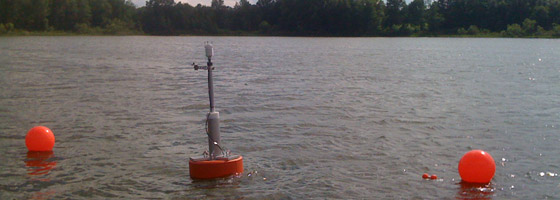Water Monitoring Buoy Systems

Water Monitoring Buoy Overview
Buoy-based profiling equipment for research and monitoring are easy to use, reliable, and capable of highly accurate performance. Additionally, the buoys are light enough to be mobile yet stable enough to withstand storms and high winds. Water quality research and monitoring entails the need for accurate and highly dependable data. As water supplies often serve as drinking water for many communities and research dollars are at a premium, buoy based profiling can provide an ideal solution.
A water monitoring buoy station typically consists of several components, including a buoy platform, data logger, solar power, telemetry equipment, mooring hardware, temperature string, sondes, and sensors. By optimizing the form and features of an environmental monitoring buoy platform, an ideal buoy can be created to match individual needs, applications, and budget.
Why Environmental Monitoring Buoys?
Data Buoys are flexible. Buoy sensors are fully customizable and water monitoring buoy platforms are designed to ensure they can be adapted and modified as water quality research and monitoring priorities change. Buoys can house from one to hundreds of sensors, meeting the needs and applications of just about all water quality work.
Data Buoys provide streaming data. With buoy-based profiling, waterway sampling can occur as frequently as every minute, providing data 24 hours a day, 7 days a week, 365 days a year, providing consistent, high quality, streaming data. This continuous stream of data provides the ability to conduct adaptive sampling or understand water conditions in real-time.
Data Buoys are independent. With solar power or battery power options, buoys don’t require an AC outlet (although they can be AC powered if desired). With several telemetry options for remote data access and sensor control, buoy platforms can communicate with servers and online systems. With minimal maintenance requirements, buoy platforms can operate for whole seasons without interruption.
Data Buoys provide real time data access. Data can be used to quickly understand what is going on in a drinking water supply, respond to changes in environmental conditions, or conduct adaptive sampling based on water conditions. Data can be shared with the public, creating greater awareness of water quality conditions, temperature, and water quality issues, or it can be private with appropriate data access controls.
Data Buoy software provides data management tools. As soon as a buoy is powered and deployed it can begin to provide data. With iChart software and the optional WQData secure web datacenter, these data are managed and easily accessed with online tools for graphing, storing, and presenting. Additionally, software can be configured to alert manager’s cell phones or email if water quality parameters exceed certain thresholds, removing the need for someone to continuously monitor the data.
NexSens Water Monitoring Buoys
NexSens MB-300 and MB-500 Data Buoys are designed specifically for offshore water monitoring systems. The floating platform supports both topside and subsurface environmental monitoring sensors with options for spread spectrum radio, cellular, and satellite data transmission to shore. Temperature strings, multi-parameter sondes, Doppler current meters, weather stations, and other monitoring instruments can be quickly deployed in reservoirs, lakes, rivers, streams, and protected coastal waters.
The buoys are constructed of an inner core of cross-linked polyethylene foam with a tough polymer skin. A 6″ diameter PVC pipe passes through the center of the buoy for quick deployment of subsurface instruments. On the topside, a hinge-mount aluminum tower offers quick access to instrumentation for calibration and maintenance. Three topside cutouts accommodate NexSens SP5 solar power packs, which include a 5-watt solar panel, charge regulator, and 8.5 A-Hr SLA battery housed in a watertight enclosure. Top and bottom-mounted stainless steel eye-nuts support mooring lines and lifting rigs for quick deployment.
The 300 lb. and 500 lb. buoyancy buoys are designed to accommodate NexSens SDL500 submersible data loggers. The SDL500 is configured with five sensor ports for connection to industry-standard digital and analog sensor interfaces, including RS-485, SDI-12, 1-wire temp string, 0-2.5V, pulse count, and more. Each sensor port offers a UW receptacle with double o-ring seal for a reliable waterproof connection. NexSens iChart Software is a Windows-based program for interfacing both locally (direct-connect) and remotely (through telemetry) to a single Data Buoy or network of Data Buoys.
For more information on water monitoring buoy systems, please call 888.426.2151 or email info@nexsens.com.




0 comments